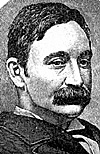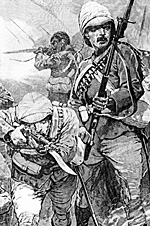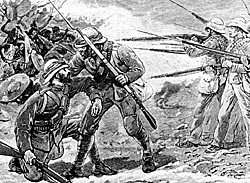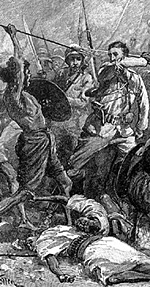 As over 14,000 dervishes charged towards a British square consisting of 1,500 British soldiers and sailors at the wells of Abu Klea, a huge man armed with a cavalry sabre fought desperately for his life as he tried to wield off the ferocious spear thrusts of the Mahdi's fanatical warriors. The career of forty three-year-old Colonel Frederick Gustavus Burnaby, Victorian globe-trotter and son of a Nolfolk vicar was about to be terminated in the bloody hand-to-hand battle being fought in the Bayuda Desert on 17th January 1885.
As over 14,000 dervishes charged towards a British square consisting of 1,500 British soldiers and sailors at the wells of Abu Klea, a huge man armed with a cavalry sabre fought desperately for his life as he tried to wield off the ferocious spear thrusts of the Mahdi's fanatical warriors. The career of forty three-year-old Colonel Frederick Gustavus Burnaby, Victorian globe-trotter and son of a Nolfolk vicar was about to be terminated in the bloody hand-to-hand battle being fought in the Bayuda Desert on 17th January 1885.
Exactly twelve months earlier, General Gordon had boarded a train at Charing Cross Station on the start of his joumey to take up his new post as Governor of the Sudan. The Mhadi's army had besieged Gordon's headquarters at Khartoum and the British Government had ordered the general to evacuate the town, but the Victorian hero had stubbornly refused to leave, forcing Prime Minister Gladstone to send a force under the command of Lord Wolseley to retrieve him and re-establish the Khedive of Egypt's authority over the war torn region.
Lord Wolseley organised his command into two forces, a River Column and the Desert Column. He requested the services of Colonel Burnaby of the Royal Horse Guards for the expedition but the Duke of Cambridge who had never been impressed by the flamboyant, cigar smoking officer's love of publicity had refused permission.. Undeterred as usual, the colonel had applied for leave to visit the Cape, and deliberately altering his travel plans he had joined the Desert Column on an unofficial basis, much to the delight of his fellow officers of the Blues who formed No. 2 Company in the relief force's Heavy Camel Regiment.
Orders
On reaching Korti at the end of November Brigadier-General Sir Herbert Stewart had been given command of the Desert Column by Lord Wolseley. The camel-mounted task force was issued with orders to push on as swiftly as possible across 176 miles of the Bayuda Desert to Metemmeh via Jakdul Wells where the Guards had built two stone forts and a camp site to accommodate the troopers and infantrymen along with their camels.
On the 14th January 1885 the Desert Column, leaving three companies of the Royal Sussex Regiment to guard the wells, left Jakdul and started on its march to Metemmeh where it was planned that the relief force would embark on paddle steamers which would convey them up the Nile to Khartoum.
Organization
The Desert Column consisted of the First Division of the Naval Brigade, a squadron of 19th Hussars and the Camel Corps. The Camel Corps had been formed into four regiments. The Heavy Camel Regiment (Household Cavalry, Dragoons and Lancers), the Guards Camel Regiment (Grenadiers, Coldstream and Scots plus a fourth Company of Royal Marines) and the Mounted Infantry Camel Regiment which was made up of four companies of hand picked men most of whom had served in South Africa or Egypt.
A Light Camel Regiment was also organised from the Hussar regiments which was designed to carry out convoy work as the relief follce advanced. A Royal Engineers detachment, half a battery Royal Artillery, 400 men of the Royal Sussex Regiment, one company of the Essex Regiment, a bearer company, a field hospital and transport details made up the remainder of General Strewart's desert force which totalled 1,900 men plus 300 natives, interpreters and camel drivers.
Colonel Burnaby wearing an astrakhan lined dark blue reefer jacket and armed with a four-barreled Lancaster pistol had arrived at Jakdul Wells known to the troops as Jack's Pool just as the Desert Column was about to move out.
This was not the colonel's f1rst African campaign. He had taken part in the Egyptian War in 1882 and had been wounded at the Battle of El Teb which had been fought the previous year. Colonel Burnaby had been attacked by the press and caused a great deal of controversy among the British public by using a shotgun against the dervishes during the battle even although it was standard practice for the Army to use dum dum bullets to stop the charging tribesmen.
Riding forty abreast the soldiers of the Queen were now entirely at home on their ships of the desert. Colonel Burnaby, who had not arrived in time to master the knack of riding an oont, was mounted on Moses a small grey polo pony which he had borrowed from Lieutenant Marling V.C. of the 60th Rifles.
Due to the scarcity of water many of the men in the relief force had grown beards while their eyes were protected from the blazing sun with blue tinted goggles. Their white sun helmets had been stained with tea and they had been issued with loose khaki serges, brown leather bandoliers, yellow Bedford cord breeches, dark blue puttees and brown ammunition boots. Each of the NCOs and men were armed with a Martini-Henry which could be fitted with a 22-inch wavy sword bayonet.
During the second day's march the force's Hussar scouts came across horse tracks and traces of the enemy's camp-fires and later in the morning dervish scouting parties could be seen in the distance observing the movements of the advancing British force. The columnn halted on an area of level ground and the soldiers set about constucting a zeriba for protection during the night.
As the officers and men bedded down and tried to sleep, huddled in their greatcoats, the dervish drums beat out a steady warlike rhythm bringing back memories of the night before Ulundi to the soldiers who had served in the Zulu War. Snipers fired on the encampment at regular intervals but Colonel Burnaby undeterred by the enemys' war drums and constant rifle fire mounted his pony and trotted out into the night on a solitary desert reconaissance, nonchalantly puffing at one of his giant cigars.
Square
On the 17th January General Stewart gave arders for the square to be formed. The general placed two companies of the Mounted Infantry at the left front face of the square. The Coldstream Guards were positioned on the right front face along with three screw-guns guns of the Royal Artillery which were situated in the centre. The left face consisted of two companies of the Mounted Infantry and No.5 Company of the Heavy Camel Regiment. The right face consisted of the Scots Guards, the Grenadiers the Marines and a detachment of the Royal Sussex.
The rear face under the command of Colonel Burnaby consisted of No. 1, 2, 3 and 4 Companies of the Heavy Camel Regiment with the bluejackets of the Naval Brigade manning a Gardner gun which was positioned at their centre.
The square was formed by forming the men in two lines on each face with the staff in the centre. When the dervishes attacked they would face 300 rifles sighted at them on three sides of the square while 235 would target them on the left. Eight hundred baggage camels driven by Aden drivers dressed in red turbans and blue jerseys with brass identification labels were placed in the middle of the formation along with the staff.
At 9 a.m. the desert force was ready to move against the dervishes. The British force's line of march was designed to proceed up a valley which had a broad watercourse filled with lumps of grass and scrub running down its middle. As the regimental bugles sounded and heliographs flashed from the rough stone forts which the soldiers had constructed on the surrounding hills, the cavalry scouts of the 19th Hussars mounted on wiry grey Syrian stallions acquired from the Egyptian Army cantered smartly down the valley as the British square moved into motion on its perilous journey. As the square advanced across the stony uneven ground to the right of the watercourse, the dismounted infantrymen marching at the front could see a line of coloured flags to the left marking the enemy's main position.
Armed with Remingtons, dervishes immediately concentrated heavy rifle fire upon the approaching closely packed formation. Colonel Barrow leading ninety Hussars was sent to the left of the square with orders to ride along the spur of land on the north of a hollow. The troopers' orders were to move in a line parallel with the formation in order to prevent any attacks on the left of the square from the high ground beyond the depression.
 As the dervish snipers tried to get closer to the advancing force General Stewart issued orders for skirmishers drawn from the Mounted Infantry and Guards to double out and position themselves seventy five yards from the formation to check the enemy riflemen from getting any closer. A second detachment of Hussars consisting of thirty men rode on the square's right front to support the exposed positions of the skirmishers.
As the dervish snipers tried to get closer to the advancing force General Stewart issued orders for skirmishers drawn from the Mounted Infantry and Guards to double out and position themselves seventy five yards from the formation to check the enemy riflemen from getting any closer. A second detachment of Hussars consisting of thirty men rode on the square's right front to support the exposed positions of the skirmishers.
The formation continued to advance steadily up the valley halting frequently to allow the stretcher bearers to pick up the casualties and carry them to safety behind the walls of the zeriba. The square pushed on keeping the hollow 300 hundred yards to its left. The hills on either side of the formation were now swarming with tribesmen running parallel to the formation. The dervish marksmen were armed with Remington's but like the Zulus the tribesmen they had a tendency to aim high when marking a target. The formation continued to advance like a huge machine slow, precise and regular in spite the hail of dervish bullets pouring in on it while the Hussars directed their carbine fire on 4,000 tribesmen who tried to turn the left of the square without success as the British force moved rapidly past the enemy's outlying flank. Beating their battle drums 5,000 dervishes formed in two lines appeared on the side of the square held by the troopers and infantrymen of the Heavy Camel and the Mounted Infantry Regiments.
 Charge of the Dervishes
Charge of the Dervishes
As the square was nearly abreast of the dervish position the tibesmen attacked by wheeling to the left. Waves of tribesmen led by their standard bearers carrying their battle flags poured down on the square to within 300 yards of the British force's bayonets and commenced to rush at the Desert Column's formation. Charging towards the left angle of the square as they came closer the great mass of men suddenly swerved around hurling their main might on the rear corner of the formation where the bluejackets were positioned with their Gardner Gun.
As the dervishes charged towards the corner Lord Charles Beresford commanding the Naval Brigade decided that the Gardner would be more effective if positioned outside the square and the troopers of the Heavy Camel Regiment were ordered to open up a gap and let the bluejackets manhandle their machine gun through the British lines.
As the sailors rolled their machine gun into position a gap sixty yards wide had appeared in the square between No. 5 Company positioned on the formation's left face and No.4 Company situated at the rear. As the bluejackets prepared to fire their machine gun Colonel Burnaby ordered No.3 Company to wheel outwards from the rear face to support the bluejacket's Gardner which was positioned on the troopers' left. As they did so No.1 and No.2 Companies began moving to their right to back up the troopers of Company No.3 while the men of the Sussex positioned on the the right faceof the square tried to cover the positions vacated by the dismounted camel troopers.
Luck was not on the British side. After firing only thirty rounds at the dervishes from their exposed position the bluejacket's machine gun jammed. Colonel Burnaby immediately ordered No.3 Company to wheel back to it's original position in the formation but the dervish attack was so ferocious that the tribesmen taking advantage of the troopers attempt to regain their original in the square poured into the opening over running the bluejacket's machine gun.
Colonel Burnaby had been first to face the dervish assault, when mounted on Moses he had ridden out to cover the last of the skirmishers--including Smoke a small terrier--as they raced for their lives with the enemy's bullets whistling around their ears, towards the safety of the square.
Seemingly impervious to the fact of the fact that he was surrounded by thousands of charging tribesmen the colonel seemed reluctant to ride back behind the protection of the dismounted troopers' bayonets.
Hand-to-Hand
A mounted emir charged at the Blues officer but was knocked from his saddle by a stray bullet. Following close behind his leader a warrior armed with a spear made straight for the huge cavalryman pointing the eight foot long weapon at the officer's throat. Bringing Moses to a halt and slowly reining back, the colonel leaned forward in the saddle and efficiently parried the dervish's spear thrust with his sabre. As the desperate duel continued Colonel Burnaby tried to thrust his weapon under the warrior's guard but the length of the dervish spear prevented the officer's sword from reaching its target.
 A second tribesman charged at the officer from his right hand side and with a sudden bound ran his spear-point into the colonel's shoulder. Although the wound was slight it caused Colonel Burnaby to turn in his saddle in order to defend himself from the new source of danger. Corporal Mackintosh of the Blues spotting that his colonel was in trouble ran out from his position in the square and bayoneted the warrior from behind but as the NCO withdrew his weapon he was killed by the attacking tribesmen.
A second tribesman charged at the officer from his right hand side and with a sudden bound ran his spear-point into the colonel's shoulder. Although the wound was slight it caused Colonel Burnaby to turn in his saddle in order to defend himself from the new source of danger. Corporal Mackintosh of the Blues spotting that his colonel was in trouble ran out from his position in the square and bayoneted the warrior from behind but as the NCO withdrew his weapon he was killed by the attacking tribesmen.
The colonel's brief sideways glance had been enough to give his dusky opponent the chance he had been waiting for and the warrior drove his spear point at the officer's unguarded throat. For a few seconds the wounded cavalryman managed to stay on his feet before falling heavily on to the stony ground surrounded by half a dozen fanatical spear carrying tribesmen. Mortally wounded the officer managed to struggle to to his feet and with blood spurting from his jugular vein he continued to defend himself with his sabre. Private Wood of the Grenadier Guards fought his way to Colonel Bumaby's side but it was too late. The Victorian hero had fought his last battle.
Tide Turned
The tide was now turning in the British force's favour. The unfortunate camels had saved the day as the rear face of the formation had been pushed back on to a wall of dead and wounded animals in the centre of the square, acting as a barrier and preventing the force from further retreat. The Mounted Infantry and the Guards at the square's front face had now turned inwards and being positioned on a slight rise were able to fire over the heads of their comrades into the mass of tribesmen.. Soon every warrior in the square had been dispatched and it was evident that the fury of the dervish attack was petering out.
Thirty yards outside the square Colonel Burnaby lay dying. A huge spear lay across his body while Moses, which had been stabbed and hacked to pieces by the dervishes' weapons, lay beside him. Lieutenant Marling the pony's owner who had survived the battle cut off a piece of Mose's tail as a souvenir.
The Desert Column had lost nine officers and 65 men while nine wounded officers and 85 men were being attended to by the medical orderlies. Over 1,000 dervishes lay dead around the position where the soldiers of the Desert Column's square had faced the tribesmens' ferocious and courageous attack.
A Union Jack was draped over the colonel's body which was carried to be buried with the other casualties under a stone cairn twenty yards away from the spot where he had been killed during the desperate hand to hand battle.
The Victorian legend who been the first man to make an aerial flight across the English Channel was dead. The dervish tribesmen who had been cut down by Colonel Fredenck Burnaby's shotgun at El Teb had been avenged by the spears of the Mhadi's warriors at the Battle of Abu Klea.
The Desert Column
The Staff: officers and 6 men
The Heavy Camel Regiment
- C.O., Adjutant, Medical Officer, Quartermaster
No. 1 Company (1st & 2nd Life Guards) 4 officers 85 n.c.o.'s and men
No. 2 Company (Royal Horse Guards & Queen's Bay's) 4 officers 36 n.c.o.'s and men
No. 3 Company ( 4th & 5th Dragoon Guards) 4 officers 86 n.c.o.'s and men
No. 4 Company (Scots Greys Royal Dragoons) 4 officers 86 n.c.o's and men
No. 5 Company (5th & 16th Lancers) 4 officers 6 n.c.o's and men
The Guards Camel Regiment C.O.
- Adjutant, Quartermaster, Medical Officer, Signals Officer
Grenadier Guards 6 officers 43 n.c.o.'s and men
Coldstream Guards 4 officers 43 n.c.o's and men
Scots Guards 4 officers 43 n.c.o's and men
Royal Marines 4 officers 102 n.c.o's and men
The Mounted Infantry Camel Regiment
- Commanding Officer,Adjutant,Quartermaster, 2 Staff Officers
A Company
-
South Staffordshire Regiment 6 officers 120 n.c.o.'s and men
Black Watch (30 from each regiment)
Gordon Highlanders KRRC (60th Rifles)
B Company
-
West Kent Regiment 5 officers 120 n.c.o.'s and men
Sussex Regiment (30 from each regiment)
Essex Regiment
Duke of Cornwall's Light Infantry
C Company
-
KRRC (60th Rifles) 5 officers 120 n.c.o.'s and men
Rifle Brigade (60 from each regiment)
D Company
-
Somerset Light Infantry 5 officers 120 n.c.o.'s and men
West Kent Regiment (30 from each regiment)
Connaught Rangers
Royal Scots Fusiliers
Light Camel Regiment
-
C.O., Adjutant Quartermaster, Medical Officer
3rd, 4th, 7th, 10th, 11th, 15th, 18th, 20th, 21st Husssars 18 officers 387 n.c.o's and men (43 from each regiment)
19th Hussars (2 Squadrons) 9 officers and 121 men
The Naval Brigade First Division 5 officers and 52men
1/1 Southern Battery RA 4 officers and 39 men
Royal Sussex Regiment 16 officers and 401 men
Essex Regiment (1 Coy) 3 officers and 55 men
Commissariat & Transport Staff 5 officers and 72 men
Medical Staff 3 officers and 50 men
A total strength of ninety-eight officers and 1,509 men. Excluding the Light Camel Regiment convoy, there were 2,228 camels and 155 horses. The Guards garrison at Jakdul consisted of nineteen officers and 365 men plus twenty-seven Royal Engineers and eleven medical staff.
Back to Colonial Conquest Issue 12 Table of Contents
Back to Colonial Conquest List of Issues
Back to MagWeb Master List of Magazines
© Copyright 1996 by Partizan Press.
This article appears in MagWeb (Magazine Web) on the Internet World Wide Web.
Other military history articles and gaming articles are available at http://www.magweb.com